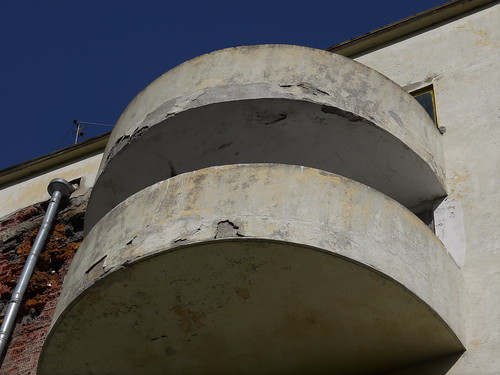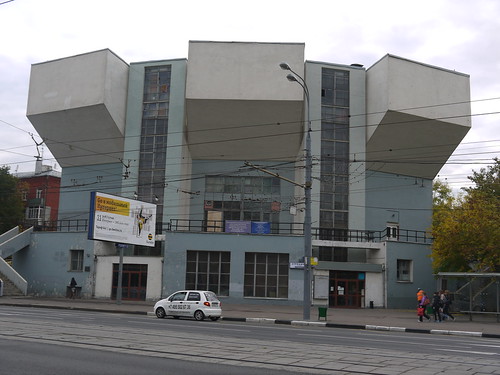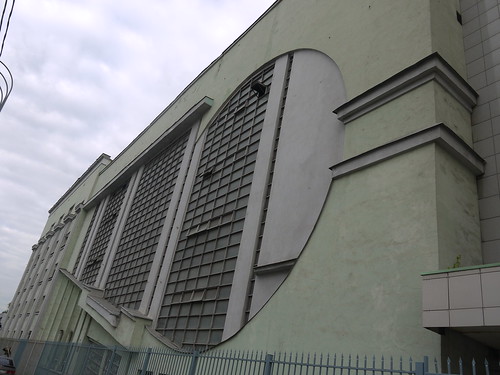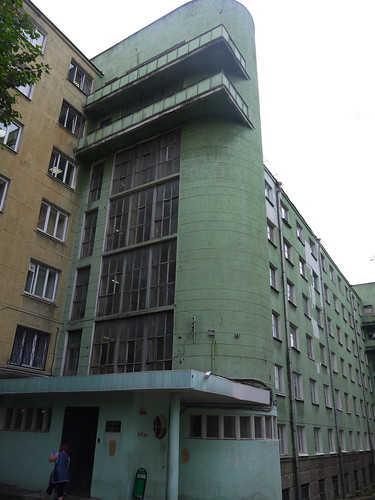I am a self confessed Russophile. When planning my recent trip to Azerbaijan, it occurred to me that I could spend a few days in Moscow on the way back, and so a little impulsively I tacked four nights in Moscow on to the end of what was meant to be just one week away in the Caucasus!
Having been before and visited the usual tourist sites - St. Basil's Cathedral, the Kremlin, etc. I decided to do something a little different. There have been a number of Russian themed exhibitions in London recently, including "Building The Revolution" at the Royal Academy and the constructivism exhibition at Tate Modern last year that focused on the works of Rodchenko and Popova. I loved both of these exhibitions and decided to go and take a look at some of the buildings myself, and to have another look at the avant-garde artists of the 1920's and 1930's.
I spent a day and a half touring Moscow by Metro, by bus, by taxi and on foot to track down some of the remaining constructivist buildings which are scattered across the city. I will write about just a few of them here. Many are in a very poor state of repair - the Narkomfin building and Melnikov's house, probably being in the worst state. Others continue to function, such as the Intourist garage and the Izvestia building, whilst others have been damaged by ugly extensions or other factors.
There seems to be a complete lack of understanding in Moscow about the cultural importance of these buildings and indeed, if nothing else, of their potential financial value were they to be restored (not renovated please note), marketed as tourist attractions, or in the case of Narkomfin, brought into use as private flats (I can hear the architect and the original inhabitants turning in their grave at this, but there appears to be no state willingness to rescue the building which is pretty much derelict). I can see no good reason for this neglect - there is no lack of money in Russia for building projects, although it was proposed to me that constructivism = communism = bad and therefore worthless in the few of many people. It is ironic that Stalin rejected and suppressed constructivism - it seems fated to be unloved.
In the years immediately following the revolution of 1917, architecture and the arts generally were used to try to shape a new society, one built on communal living. Built in 1930, the Narkomfin is a prime example of this. It included communal cooking facilities and a dining room, a somewhat bourgeois rooftop swimming pool (!) - communal laundry and showering facilities, library, and gymnasium. Of the 54 flats in the building, none (at least legally) had their own kitchen. However, the Soviet utopia showed cracks fairly early on and Stalin specifically disliked the Narkomfin, referring to it as "Trotsykist". It is located at 25 Novinskii Bulvar.
The main body of the Narkomfin is not especially beautiful but its iconic balconies (pictured below and which would not be out of place in Tel Aviv) and its communal dining facility give clues to how it once looked. Jewish architect Moisei Ginsburg designed the Narkomfin, as well as being a writer and teacher. He was enthusiastic about Le Corbusier's philosophy and must have been thrilled when the Swiss architect listed the Narkomfin as one of his own sources of inspiration. Ginzburg initially resisted the state pressure to turn back to historicism in architecture, going so far as to speak in defence of artistic independence for an hour at the first Congress of Soviet Architects in 1937, but like many others, he too eventually took discretion to be the better part of valour and conformed.
 |
| Balconies of the Narkofin building |
The Narkomfin is my personal favourite Constructivist building in Moscow, but I also have a strong admiration for the works of architectural genius Konstantin Melnikov. Melnikov worked for the regime designing a number of workers' clubs, bus garages and of course, his own private residence in the Arbat quarter. He won a competition to build a number of workers' clubs across Moscow. The clubs were an important part of the regime's plans to collectivise society, providing education, propaganda and community centre functions for workers living in the vicinity.
The Rusakov Workers' Club is, to say the least, an extremely unusual building, with three cantilevered sections at the front holding seating areas but which could also be used as completely independent halls or linked together to seat 1000 people. I understand that the current drab colours were not the original, but a clue to a more vibrant look can be found at the rear where some areas of red remain! It is unlikely that such a building could have been constructed much later than this as by 1930 Stalin wished to move to a more historicist (and less interesting or challenging) style. Melnikov designed no further buildings for the state and retired from architecture in 1933.
 |
| Rusakov Workers' Club |
One of his most striking works - the Intourist Bus Garage (pictured below) was completed after his retirement in 1934. The facade of the garage is retained today but Melnikov had plans for a much grander structure than even this. Unfortunately his plans were not deemed appropriate and a dull looking wing was added to the building to complete it. The garage is still used by Intourist and can be found at Suchevsky Val Street 33. Although it may be a little worse for ware, the garage is still in use and is in a much happier condition than Melnikov's own house at Krivarbatskii Pereulok 17. The house is locked and appears deserted. It has been the subject of a protracted legal battle including Melnikov's (now dead) son to his first wife and Melnikov's final, much younger wife who is since remarried to an extremely wealthy businessman. Her new husband has purchased the adjacent land, and built mock "old" houses on it. The vibrations from those building works caused significant damage to the house. The garden is badly overgrown so its hard even to take decent photographs now and the sign stating the house to be under government protection seems to be fairly meaningless.
 |
| Intourist Bus Garage |
The architect described his house as consisting of two cylinders, one eleven metres high, the other eight metres, intersecting for one third of their diameters. The internal space is allocated to three near circular spaces dedicated respectively to sleeping, living and working. Melnikov described the ground floor kitchen and dining area as the "stomach" of the house, the first floor bedroom and living room as its "heart" and the top floor studio as its "brain". The hexagonal windows were designed to cast light that is both intense and even in line with his belief that a good sleep depends on the quality and amount of available light. He would be somewhat distressed today as most of the natural light must have been blocked by the overgrown garden and adjoining structures. He was heavily criticised both for the design and for the idea of having a large private space which was completely against the prevailing philosophy if not the law. Thankfully, he seems not to have cared!
A much lesser known building is the former dormitory and club of the Markhlevsky Communist University of Ethnic Minorities (pictured below). Located at Petroverigsky Lane 8/6, this beauty was built between 1929 and 1931 and was a designed by the architect Dankman. The original plans had a communal dining area and other shared facilities as well as the dormitory. Although not in the same state as the Narkomfin, it is in poor shape but according to the external sign, it is being used for student accommodation.
 |
| Former club and dormitory of the Markhlevsky Communist University of Ethnic Minorities |
There is an excellent book on the architecture of the constructivist and other twentieth century styles in Moscow - "1920-1960 Moscow Architecture Guide Book" by Natalia and Anna Bronovitskaya, published by Giraffe in 2006. I have been unable to track a copy down. Let me know if you find one!
The Tretyakov Museum's collection of Russian avant-garde art from the 1920's and 30's has to be the best of its kind. Until recently it was housed at the beautiful Tretyakov building in Lavrushinksy Lane with the museum's extensive holdings of earlier Russian art, including a magnificent collection of icons, religious and historical paintings. The avant-garde works are now housed in the new Tretyakov in a major development at Kultury Park.
The collection is breathtaking with room after room of some of the best and most original art ever produced. The first room is given over to the early works of Goncharova and Larionov and includes a textual summary in English as well as Russian. The early years of the twentieth century and indeed the years immediately following the Revolution were a period of immense creativity and also artistic freedom in Russia. The series of exhibition rooms tracks progress from this early flowering, through the darker days of the early 1930's and then the eventual total state control of artistic expression and the official turning against the avant-garde as the 1930's came to a close.
 |
| Peacock Bright Sunlight by Natalia Goncahrova |
This first room includes Goncharova's "Peacock -Bright Sunlight" from 1911 (left) and "Parrots" from 1910. I was struck by the "bigness" of the paintings. Although not particularly physically large, they dominated the room for me with the "thick" paint and tropical colours, whilst Larionov's "The Waitress" of 1911 also stopped me in my tracks. I can't imagine a work of this nature being allowed in the later 1930's. It shows a well dressed customer standing rather too close to a waitress. There are very strong sexual overtones to the painting - he almost touching her, her with one hand tucked behind her back and the other safely in her pocket, but her expression clearly wanting the closeness. The class differences between the two are obvious and in the background, its possible to make out the scandalised faces of the other cafe customers.
 |
| Jews on the Street by Natalia Gocharova |
There are a number of Goncharova's paintings of peasants, but I was particularly struck by her "Jews on a Street" (right) of 1912, showing three Jewish women of different ages, two with heads covered and the third a dark haired almost-beauty. Bread, fishes and wine can be seen in the background - for me these are strong Christian references, but who knows what the artist meant by them?
Amongst the highlights of my visit was seeing Rodchenko's "Workers' Club" of 1925, complete with functional red wooden seating, racks for the display of journals, angled reading desks and even special seating with a built-in chess board for keen players! This particular plan was never realised but it is not hard to see the influence his proposals have had on a number of current designers, including some involved in library design. I would have been very happy to have been able to sit down, take a magazine or a book from the rack and pass several hours relaxing. There was also to have been a "Lenin corner" featuring his portrait and no doubt copies of his speeches - at least the non-realisation of this project spared the workers that!
Lyubov Popova has a number of works on display - including some graphic work. Many Russian artists of the early 20th century were involved in costume and theatre design as well as painting. Popova's "Costume for actor number 5" (1921), for a play called the Magnanimous Cuckold is an example of this multi disciplinary approach by artists of the period. The character's name is re-assuringly Soviet!
The graphic collection is enormous and also includes some interesting works by Sergey Senkin - a photomontage from the late 1920's entitled "City", Yuri Yurkun's watercolour "Ladies and cavaliers" of 1935 Alexander Tyshler's two works from 1930 "Decreed to take off the veil" and "Listening about the veil". I like these not just because they are great works of art in themselves, but also because they describe the changing political mood in the Soviet Union from the early 1920's to the late 1930's. Tyshler's works show central asian women listening to a commissar telling them that they were being liberated from their veils by the State - a real historic event and there are photographs and memoirs describing the ritual burning of the veils. It is intriguing that having disposed of them back in the 1930's, then being liberated from Communism twenty years ago, there is a movement to put them back on in some parts of Central Asia. These countries exchanged one kind of oppression for another back in the 1930's. History has a habit of repeating itself.
Senkin's photomontage of skyscrapers and street scenes illustrates the high hopes many people had in the early 1920's in the Soviet Union. It seems to express a new optimism when technology would bring many benefits. As we know the optimism was short lived and Yurkun's watercolour from 1935, a coquettish image of "lades" and "gentlemen" flirting with each other is probably one of the last times such an image would scrape by as acceptable under Stalin. Recent writings about Yurkun, indicating a long time intimate relationship with poet Mikhail Kuzmin may also give additional meaning to the picture - perhaps redefining it as a challenge to the virulent persecution of homosexuals and others deemed anti-Soviet under the communist regime.
 |
| Self portrait - Nathan Altman |
Two of my favourite artists are also featured in the exhibition. Armenian Matiros Saryan was heavily influenced by his cultural heritage. He has four works on display at the moment and two of them - "Old Yerevan" and "My Family" especially demonstrate his commitment to his background. The main art gallery in Yerevan has a great collection of his works as does the Saryan House Museum, also in Yerevan.
My other favourite - Nathan Altman - is represented here by a self-portrait from 1912 (right), a depiction of a "Provincial town square, Minsk" from 1926 and a surprising sculpted self-portrait from 1916, entitled "Young Jew" complete with side locks!
I pretty much had the gallery to myself. Whilst this was great for me, this would not have been the case at the old location. The nearest metro station is Kultury Park which is a fifteen minutes walk over the Moscow River to the new site. There are no signs to help you get there and when you do reach the park there are road works everywhere - not exactly welcoming. The new home is very Soviet style - massive with huge un-used spaces (maybe there are plans), a cafe that isn't open and a tiny kiosk for a book shop. I sincerely hope they haven't made a mistake by moving this showpiece collection here. Come on Tretyakov - get it sorted! And please, not the ghastly coffee urn stuff you are selling at the old Tretyakov - yes, I spotted the wretched new urn at Kultury Park. For goodness sake!
Moscow is one of the largest cities in the world. These treasures represent just a tiny fraction of what the city holds (and often hides). I am continually struck by the overwhelming creativity of the Russians, despite their inhospitable climate and their terrible history. The Tretyakov's collection and the wonderful buildings I visited represent a very short period in Russian and Muscovite history. Future posts will look at other areas. You can see more pictures from Moscow here.
Really interesting and informed piece, thanks. I've been in the new Tretyakov a couple of times and both times there have been quite a few visitors there.
ReplyDeleteThanks for commenting. Glad to hear that the new Tretyakov has lots of visitors - its a wonderful collection!
DeleteI really enjoyed this piece very much and was greatly fired up by your reference to the "1920-1960 Moscow Architecture Guide Book by Natalia and Anna Bronovitskaya, published by Giraffe in 2006". However it seems to be utterly and completely untraceable either by title or author or publisher. The nearest I can find is a Russian title "Pamyatniki arhitektury Moskvy. Arhitektura Moskvy 1910-1935 gg." by N. N. Bronovitskaya (2012) [Architectural monuments of Moscow. Architecture of Moscow 1910-1935]. Clearly some relationship but are you able to shed any more light on it? Martin Barlow (m@mjbarlow.plus.com)
ReplyDeleteThanks for your comments. I have been unable to track the Bronovitskaya book down too and regularly search for it online. I should have searched for it when I was in Moscow!
Delete